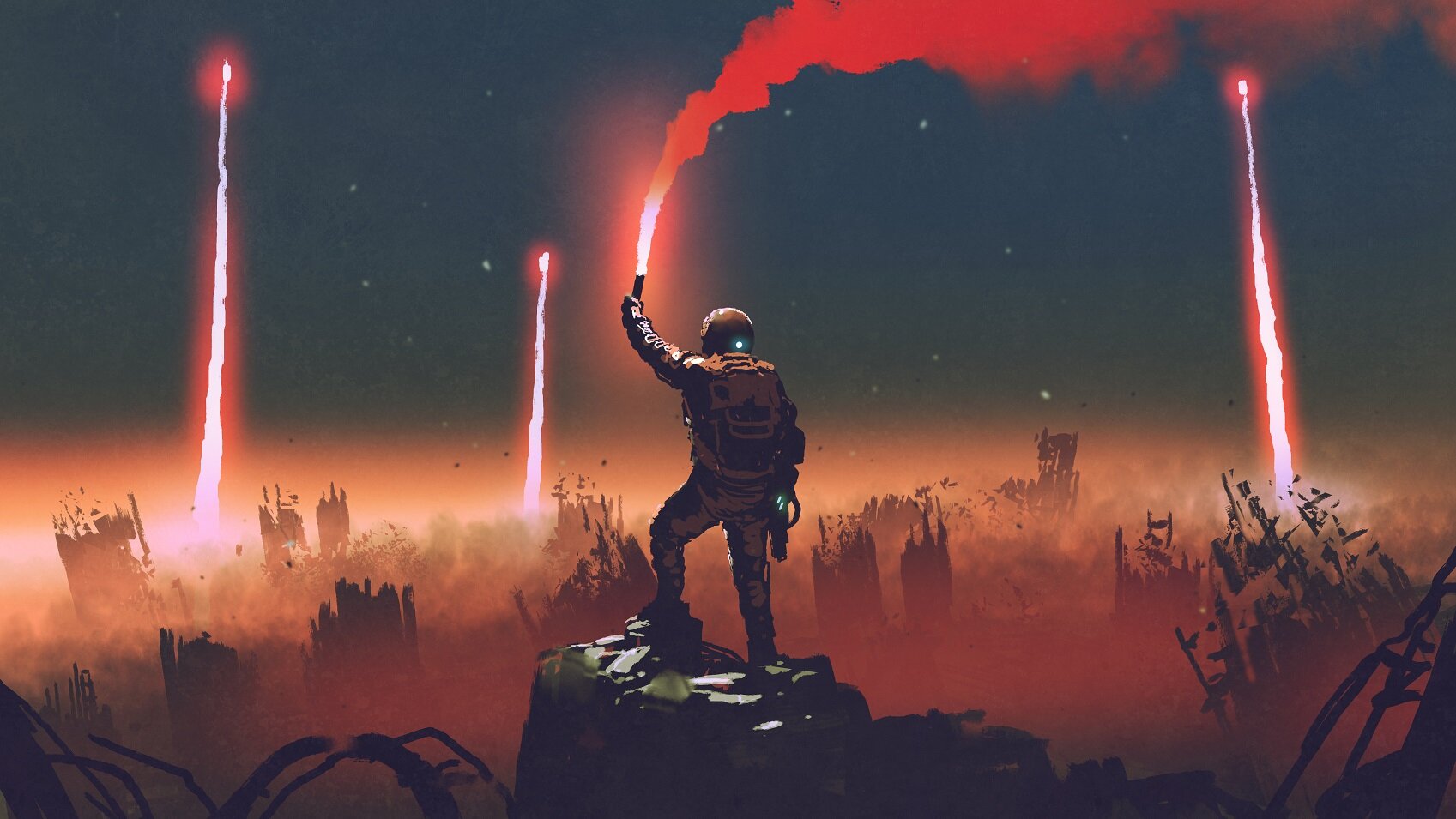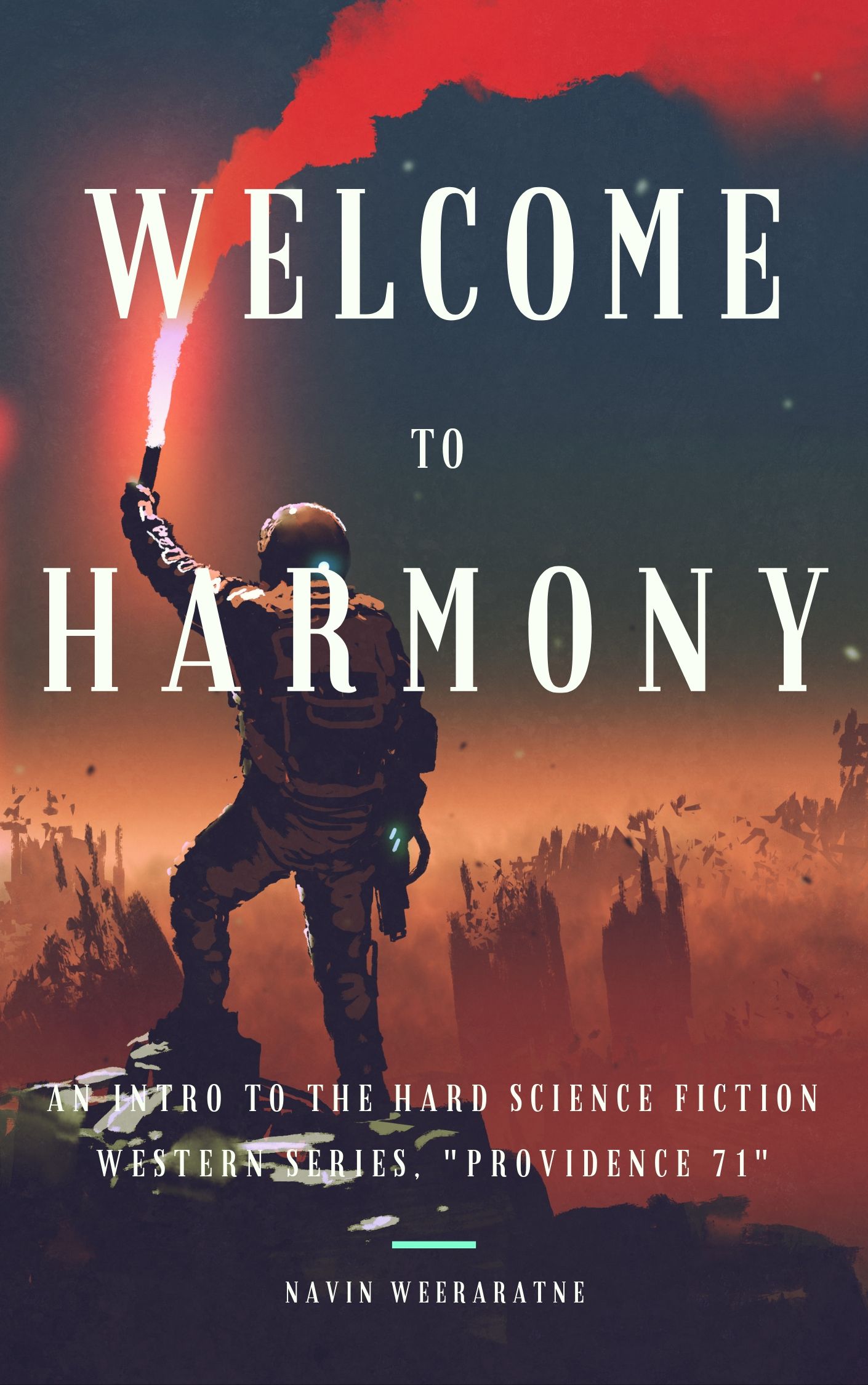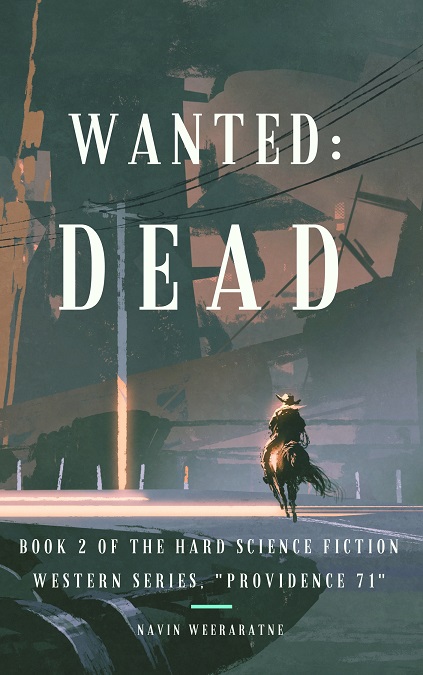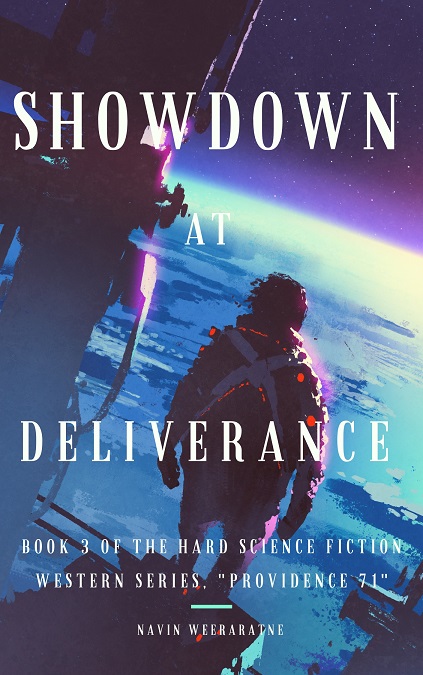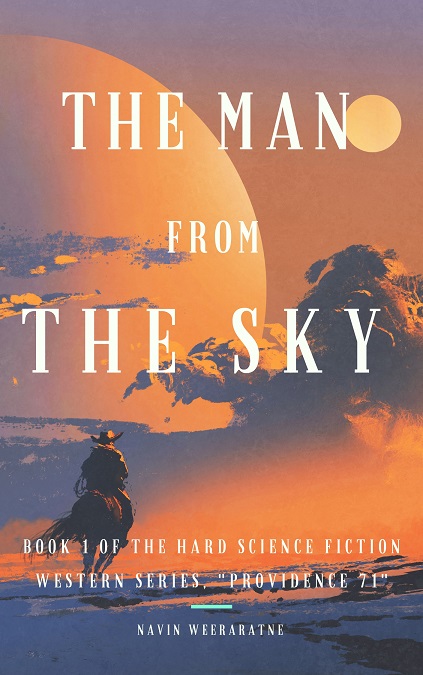2327 AD, Planet 9, 2nd Moon, “Mandir Grah”
“Now you tell me,” said the orangutan, “who builds a 100-story tall statue on an ice moon? One that takes 20,000 years[i] to orbit the Sun?”
The heirloom, SpaceX rover wrote into the geyser-fall snow with its treads. To the left were black hills: the tips of undersea mountains. They poked through the sea ice layer like coal-dusted fingers. To the right, the world ocean spanned to the horizon. Craters pocked it, and fissures cut it into a thousand petty kingdoms. Geysers split through some and fired into space, feeding the planet’s rings.
Coming up ahead, was the colossal statue.
“Humans of course. At least the old ones, the way we used to make them.”
“You guys are such a bunch of crazies.”
In the sky, the night-blue gas giant had risen. Lighter gas bands shoved past darker ones, bleeding cyclones as they cut each other. It wore a belly chain of sparks: space probes and cans of scientists. They peered down for breaks in the storms, or looked under them in x-ray wavelengths. The poles glowed with green-purple aurorae.
The orangutan sat back in his seat, and took a drag on his cigarette. He ashed it in a bowl of half-eaten noodles and greens sitting on the console. He groomed for non-existent parasites - a habit too many millions of years old to break.
“I don't know man,” he pointed at the statue through the canopy. “Is that insecurity? Cause it looks to me like insecurity. Someone needed to stamp their presence on this place, make it less like an alien wasteland they had no business in. Like putting a pink bow on a Rottweiler.”
“Maybe,” said the man driving the rover. His hair had gone to salt and pepper, and his skin was slowly turning into leather. Like the orangutan, he too wore a spacesuit, helmet and gloves removed. “Faith is often an excuse to do something that hasn’t anything to do with faith. But nevertheless, people would do beautiful things for faith. They built cathedrals, preached to barbarians, and went on voyages to new lands. Just like these people did.”
The rover made its way over the cratered ice, snow caking its wheels. The headlights were like sparks versus the floodlights that ringed the statue.
“Do you know who that guy is?” the orangutan swallowed his cigarette butt and scratched his ass.
“It’s the god, Vishnu. The Sachye Samaj Vaishnavites[ii] believed that Planet 9 was Vaikuntha, Vishnu’s home in the heavens. If there’s any place to put a statue of him, this is the place.”
The orangutan looked at a picture, and then back up at the statue.
“All the lights are still on. This image is what - a hundred years old? What are the chances no light went out?”
“Don’t get your hopes up: everything here was built to last.”
“What about the power, itself?”
“Especially the power. There’s a fusion power plant in the water, anchored just under the ice. There’s enough deuterium[iii] in the ocean below, to power this place till the heat death of the universe.”
“Everything breaks down, Jim.”
“Well if the mechanic is still around, we’ll find him.”
The rover cut a wake in the snow like a speedboat’s. Old maps showed the mounds they passed as ice-buried buildings. Their radars confirmed it. Elephant-sized ice statues lined the roadway. Their like had survived millennia on an invisible dot named Earth. Here, they would outlast the sun.
The rover stopped near the giant statue’s base and crouched down like a cat. The airlocked hatch opened, and two space suits came out. They were tethered on yellow safety lines like infants at an airport.
“Look at that!” Spencer pointed. “Is that the biggest statue your species has ever made?”
Hernandez craned his head back, Planet 9 reflecting in his visor. “It’s the biggest statue any species has ever made.”
He low-gravity-hopped to a row of waist-height ice blocks, facing the statue. Spencer followed, but then stopped to dig in the snow.
“What is that, an ice table?” asked the orangutan.
“Sort of,” Jim brushed snow away. Beneath it were clay bowls filled with flash frozen white flowers.
“What are those?”
“Frangipani,” he picked up a bowl and peered closer.
“Real?”
He tried breaking off a petal. In the ultra-cold it was hard as rock.
“It’s real.”
“That shit grows on trees, right?” the orangutan was building a snowman.
“Yes.”
“Where did they get space to grow trees?”
“Maybe on Benares before they were kicked off it. These flowers were offerings. There are fruit bowls here, too. Grapes. Papaya. Bananas.”
Jim set aside the bowl. Beneath it, there were carvings on the ice block.
“We got writing,” his suit camera AI started taking pictures. The orangutan came over. “It’s in Sanskrit.”
“Can you read it?”
“It’s a list of events, starts 2197, with the arrival. Encountering the Pytheans – the writer calls them ‘Saturn’s robots’. Their ship going into orbit around the first moon, Benares. Them declaring this moon a ‘shrine world.’”
“A whole world temple,” the orangutan made a duck face. “So that’s what those are.”
“What?” Jim looked up.
“You don’t see them?” the orangutan pointed to the line of hills a mile away. “Those caves over there. Lines of them, regular spaced. Regular sized entrances, too.”
Jim looked and zoomed his optics.
“I see them now. Could be quarries.”
“Then why not an open cast pit?” he went back to making the snowman.
“There was lots of arguing,” Jim went back to reading, “with the Pytheans, over Benares and contamination. The Vaishnavites saw it as terraforming. Seems they had no interest in the native life.”
“That’s how the Pytheans tell it.”
“You’d think strange new life would make people pause.”
“What is it that historians call it – presentism? You’re judging by our standards, you’re being presentist. You didn’t travel frozen for thirty years, to colonize God’s home. Maybe they saw the native life as roaches in a fixer-upper.”
“2215, the war begins. The author is very proud they used fusion bombs. 2217, they’re defeated, and the survivors deported back to the inner solar system,” he frowned. “It continues.”
“What do you mean?”
“The chronology continues! I thought it was decoration at first, but it’s Hindi now, not Sanskrit. The carving is cruder. 2219, ‘only me now.’ 2221, ‘garden completed.’ 2228, ‘so much work to do.’ That’s it, that’s the last entry.”
“So one person was still out here, at least 99 years ago,” Spencer dusted snow from his gloves. “And the Pythean robots didn’t know, or likely care.”
Jim looked around. “He didn’t do any work out here. Those caves, how many can you see?”
The orangutan rose up on his legs and peered. “I count – wow. Jim there are hundreds.”
“Let’s go,” he turned to leave.
“It’s been 99 years. He’s dead, Jim.”
“The Vaishnavites could survive freezing, and they didn’t cheap on medical tech.”
“Jim,” he went after him, “you’re not going to find him alive!”
“There’s no reason I can’t bring him back!”
“Jim!”
One suit, then slowly the other, reeled themselves back to the rover.
An impacting asteroid broke the ice shell, and out splashed ocean. The waves froze into hills, of which only this range survived. Snow wallpapered it for millions of years, only sheer cliffs cutting through. Some were lined with roads: built by apes from a world too far away.
They took the rover to the first tier of rock caves, and got out. Spencer moved his hands in Augmented Reality, and three drones emerged. They climbed on spikes of compressed gas, and flew ahead deploying instruments. Jim’s helmet display lit his face with their feeds.
“Something big is leaking heat up here,” he said.
“I see it,” said Spencer. “Want to take the rover?”
“No, this is an archaeological site, we have to minimize impact. Besides, it’s just at the end of this tier.”
They walked past the caves, identical-cut alcoves each twice a person’s height. In each, carved out of the ice, was a god. Some had bowls of flowers set before them. Some were unfinished – arms and legs still beaming down from a sculptor’s mind. They found hammers, chisels, and laser cutters. One statue had been smashed – its pieces lying strewn about its alcove.
“This was a Ganesh,” Spencer held up a piece of elephant trunk. “Someone was pretty pissed.”
“Ganesh is the god of obstacles.”
“I wouldn’t pray to an obstacle god.”
“He also removes then. He tests you. Forces you to grow.”
“Sounds like you have to remove them yourself.”
“Maybe that’s his lesson.”
They followed the growing infra-red stain to the end of the tier.
A small pathway had been cut, just wide enough for one person to use. It curved behind the tiered alcoves, like it was an access to backstage. It ended in a round metal hatch going into the hill. White light glowed from its edges.
“Do you think -” began Spencer. The light grew brighter, and the door slid open. Inside was a roomy airlock chamber. “Wow, still working.”
“Good low temperature engineering,” Jim, stepped past him, studying the door and looking inside. “They must have been masters of it. Come on. Let’s go see the warmest thing thing in the world.”
Through the airlock was a jungle.
Lights burned from the insulated ceiling; down below, it was tropical mid-morning. Frangipani trees were the dominant life form: the newer ones had taken over the paths and lawns. Bananas and Papayas were the weeds between them. There was almost no grass – a losing species, it would be extinct in another century. White mushrooms dominated the wet, thick, leaf litter. It churned gently – meter-long earthworms surfaced like sea monsters. Leaves exploded near a stream – an Alsatian-sized spider came out and pounced on a worm. It yanked its victim back into its makeshift burrow.
“Holy shit!” said Spencer. “This must be the garden.” He glanced at his readings. “Almost thirty percent oxygen in here. Helmets off?”
“Best not to,” Jim shook his head. “Who knows what contamination could do.”
“Okay, but this isn’t an alien environment.”
“Not in the beginning,” Jim ran has hand over a banana tree trunk. “But it is now. The plants should have grown bigger in the low gravity – they must have been engineered to stay Earth-sized.”
“Is that why we have giant monsters?”
“Actually no. It’s oxygen content that restricts bug sizes.[iv] Thirty percent – that’s as much as the Carboniferous. Millipedes grew six feet long then. It’s probably so high because the higher animals died out.”
Shadows moved over the ground. They looked up – trout-sized butterflies moved like fish, flapping rarely and just to steer. They rode a thermal - bombers off to find a small town.
“Come on,” said Jim once they’d passed. “Let’s find out what happened to the gardener.”
They found the gardener in a small cottage thatched with palmyrah leaves. Inside, nature had trashed the place: rotted cupboards and bed sheet-sized spider webs. A horse-sized centipede came running out to challenge them. Spencer twirled it like a rope and flung it over the tree-line.
“Don’t mess with great apes, bitch,” he waved after it.
Jim knelt down over the gardener. The bedding had rotted away except for shreds of artificial fiber. The skeleton was undisturbed, lying straight with its hands by its side. Silicone and metal implants lay inside the rib cage, treasures in a pirate’s chest. Other pieces studded the skull in a ring.
Beside the skeleton were fist-sized pressed statues of meteorite dirt and clay. Embedded crystals glinted in Ganesh, Vishnu, and Brahma. In front of them was a brown, hardbound book in a sealed plastic bag with ‘1/1/74’ written on it. Blue and white powder had been packed inside it.
“I’m sorry, Jim.”
The man said nothing, taking pictures of the corpse. He squatted down and got close ups of the implants.
“The plastic wrap is messing up the spectra,” Spencer passed a spectroscope wand over the book, “But I think that’s silica gel in there. It’s sucked all the moisture out. He knew this book would have to survive a long time.”
Jim picked up the meteoritic Ganesh, turning it this way and that. “There is nothing else here, no carvings, nothing. Let’s open the bag.”
Spencer cut open the bag, and gently pulled the book out. Jim took it and lightly brushed off the silica powder. He opened it – decades of religion and botany looked back at him.
“There’s a note dated January 1st 2274, right here on the first page.”
“What does it say?”
“I lived a long life, and I have been happy. I am very proud of my children, they are grown now. Please respect them, as I would respect yours. May we meet in another life time. Gopesh.”
Holographed names scrolled in the air, “There were three men named Gopesh on the Agni’s passenger manifest,” said Spencer. “One listed as KIA in the Pytheas Three Public Archive. The other they listed on the deportation flight. This guy was Lal Gopesh, power engineer. I guess that’s why this place still runs,” he looked about, “and why it ended up a fucking pre-dinosaur jungle.”
Jim sat down cross legged, reading.
“This starts in 2167, the year they left Earth. There’s a picture of his parents and his sister. It covers the whole mission – there’s bits of gossip. Arguments. He’s scribbled in footnotes with what he thought in hindsight. Spencer,” he looked up, “this is the only primary account, anyone has ever recovered, of the Vaishnavite colony mission.”
“Shit yeah motherfucker!” 400 pounds of de-extincted Mega-Sumatran, raised the roof with both arms. “We can go back, and you can become a professor!”
Jim looked up at him. “Do you want to go back?”
“Fuck no. They all look at me like I’m a roving wild life exhibit.”
Jim looked back at the book. “We missed him by fifty three years.”
“He was a crazy old hermit. What would you have in common with that?”
“Maybe everything.”
“We’ll keep looking, Jim. There are other baseline humans out there. We can find the Agni. As long as the Pytheans didn’t lie to everyone and just blew it up, it’s out there. Like you said, these guys were freeze-adapted. Perfectly normal humans, on a drifting ship somewhere. They’ll keep.”
“Yeah,” his eyes looked faraway. “We’ll just go find them now.”
“We could try a landing on the first moon, Take our chances,” Spencer shrugged. “There could be clues there, Jim. Maybe they never went back to Earth. Why would they? They could have gone anywhere. Settled a dwarf planet. Come back in a century and tried to take Vaikuntha again.”
“No, the Pytheas Mission’s quarantine is in place for a good reason. Research probes made guns and went to war, to stop people killing off the native life. We break the quarantine, we’ll seem no better than them. We’ll also make life harder for the people who live in this system. They have to get along with the probes.”
“Then let’s just ask them again. We’ve come all this way, what’s the harm? It’s just you and me, and all we want is to poke through the ruins.”
“Yeah,” he closed the book. “I hope they didn’t head for Earth, though.”
“Why is that?”
“They wouldn’t like it. You’re not the only one who gets looked at like you’re wildlife.”
They spent the rest of the day taking pictures, holos, and scans. The next morning they printed a coffin-shaped box for the remains. They drilled around the skeleton and pumped in graphene starter culture. Programmed nanites cut through the floor and built a supporting panel. Spencer popped it out – then packed the slice of floor and untouched skeleton. Jim bagged and tagged the loose implants and meteoritic statues.
When they went back to the rover, they saw a large lander parked beside it. Standing in front was a dark red space suit, and a powered armor with a rail gun - politely - behind its back.
“Who the fuck are you guys?” Spencer got up on his hind legs, tall as a grizzly bear.
“Easy buddy,” Jim held up his hand. “Hi, we weren’t expecting any visitors.”
“I’m sorry,” began the red suit, “I messaged your vehicle before landing but got no reply.” In the oversized bubble helmet was a bald woman. Her scalp was hairless, smooth as a dolphin’s. Her irises had been switched for black, neuro-optical shunts. Her skull was enlarged and planted with rows of data jack-pores. Her smile was a vampire’s. “My name is Jace Sheperd, I’m an astrophysicist, and captain of a research and exploration ship. I’ve come looking for the archaeologist, James Hernandez. I trust I have found him?”
“You have,” said Jim. “What can I do for you? We’re a little busy here.”
“We got this book,” said Spencer. “It’ll blow your mind!”
“I’m sure. Doctor Hernandez, I understand you’re interest is in historic, baseline humanity? That you’re looking for ruins and artifacts, and especially still-living, baseline communities?”
“I am. What of it?”
“I am going to visit our oldest colony sites. Baseline human settlements, from the 21st and 22nd centuries. Most fell out of contact with Earth. Most were seedship missions.”
“Seedship era? I don’t understand. How are you going to visit them?”
“We’re going to fly to them.”
“There are no hedron links to those stars.”
“We’re not going to fly through the hedron wormhole network.”
“Yeah,” Spencer looked to Jim, “I don’t get what she’s talking about, either. Also, I think Mister Power Armor here, is a deaf mute.”
The power armor kept looking out across the ice.
“The ship will travel just under the speed of light,” said Sheper, “for many years, to reach these stars. We will visit them, Proxima, Tau Ceti, Van Maanen’s Star. We will see what happened to the people there. We will learn and document the fate of those who failed. If we find struggling survivors, we will give them the best of Saturn’s technological aid.”
“Saturn?” asked Spencer. “Your sponsor is not from Earth?”
“Earth and Jupiter are taking over the galaxy. They’ve no time for the nearest stars, and those who now call them, ‘Sun.’ Saturn has always cared about such things. It is a system of introverts, asking questions. Our sponsor is a new, Transcendent mind on Siarnaq.[v] It addresses itself as Faxian - ”
“Fah Hsien?” said Spencer.
“Faxian –” Jim said it more elegantly, “he was an early, medieval explorer[vi], wasn’t he?”
“He was. China’s collection of Buddhist scriptures was incomplete. So Faxian, a monk, explored the old Buddhist lands of ancient times – India, Nepal, Sri Lanka, Bangladesh, Pakistan. He went on foot, through deserts and mountains. He made accounts of the people he saw, their lives, their stories.”
“So a Posthuman mind fancies itself a wandering monk scholar?” asked Spencer.
Jace looked at the ape. “Can you think of a better calling?”
The other two were silent.
“The colonies we didn’t hear from have their own stories,” she continued. “If only, the story of what became of them. We need to learn those stories, and there is no one in the solar system Doctor Hernandez, who wants to learn them more than you. Believe me, we have looked.
“And where those colonies survived, you will find baseline humans. They would be the only living communities of those beings, that still exist. They would be to your work, as the Andaman Island tribes are to studying the Paleolithic. That is why I have come here, Doctor. I want you to join us.”
Spencer farted.
“And your – friend, too.”
Jim looked out over the ice.
“Of course, you do not have to give me your decision now,” said Jace, pulling out a small cube from a thigh compartment. She handed it to Jim. It had heft to it, even in the trace gravity.
“What is it?” he asked.
“You can use it to contact me, we will be in the system for twenty-two more days. Then we depart for Proxima. You will also find information about the mission. Everything is there.”
She put her hands together and bowed. “It would be an honor to work with you, Doctor Hernandez.”
The transhumans boarded their lander. It climbed on gas jets that froze into snowflake sprays, before a rocket engine fired. Their helmets polarized against the bright light, the lander became a star, but did not go out.
“Direct ascent,[vii]” the rocket burn reflected on Spencer’s helmet. “She’s not wasting any time.”
Jim looked at the cube. It was grey with neon blue spilling through its vertices. It was etched with a hyper-dense language code he didn’t have the eyes or brainware to read.
“Come on,” he put it in a sample bag, “Let’s get these artifacts on board.”
“That’s it?” Spencer’s helmet swung sharply down from watching the ascent. “That’s all you got?”
“What?”
“That was the third, independent visit this moon has ever had, and she was here to see you. She didn’t message you. She didn’t call. She flew over in a spaceship!”
“She had business in the system, you heard her.”
“What business could she have, that she couldn’t do elsewhere? You’re the only Jim Hernandez!” he poked him in the chest. “There are no forks of you. No clones. You’re as baseline as the day your mom shat you out! She came for you buddy, nothing else! No one else! Can you imagine how important this must be?”
“Only to some Posthuman machine mind, growing into a small moon, like a cancer. Don’t think too much of it, Spencer. We can’t predict how Transcendent AIs think, or what they might value on a given day. They’re constantly growing, evolving in place. They’re as far from their starting builds, as we are from ants. They’re pocket Singularities[viii] - ongoing industrial revolutions as living creatures. She said it was a new one, that makes sense then.”
“How?”
“They’re active when they’re younger. Then they hit a tipping point, and become self absorbed. There’s a tech company seeding them on Psyche - they’re experimenting with sun shades to energy-starve them, to stretch out the Peak Innovation stage.”
“I can’t believe you. Jim, she just offered you a ticket to go find other humans. Original pattern humans. The smelly ape kind. And you don’t give a green shit.”
“I’m not in the habit of joining people I’ve just met who want to take me to other worlds. And we’re already looking for baselines, Spencer. The Agni is out there. Six hundred people in freezers, drifting around the sun. We need to find them.”
“And if we somehow find the ghost ship Agni, then what? You’re going to hang out with them? In their minds, they just lost a war, yesterday. You want to live among six hundred people with PTSD, who will always see you as some fan boy outsider? They’re religious fundamentalists, Jim.”
“It’s a treatable illness.”
“Listen to yourself!” he threw up arms almost as long as a man. “Since you thawed out, do you know how miserable your life has been? You’ve spent years Jim, scouring archives, dead ships, busted cryo-freezers, trying to find other people.”
“I’m an archaeologist! I’m trying to do my job. There are people I can interview, history now lives past its expiration date!”
“It’s not about the archaeology, it’s about you. You’re the exhibit. You belong in a museum.”
“And you belong in a zoo!”
“Just look,” Spencer pointed at a random star. “Do you see that? That’s the Sun, Jim. There is no one else looking at it right now, who is like you. You’re the only one. You’re the only one.”
Jim looked at the Sun, and it took away his words.
“I’m the only one of my kind, too,” said Spencer. “No other ‘let’s-make-this-one-smart!’ atrocities.”
“So? You can always make more. That’s always been an option for you.”
“And for you. Would you go make more baselines? Yeah. See? It doesn’t work that way. I’m just someone’s conceit, a ‘good-idea-at-the-time’. But, I have peace knowing there’s no one else. You though,” he shook his head. “You poor bastard, have the bad luck of hope.
“We’ve searched so far, we need instruments to find the Sun. We’re years and years from Earth. What’s the harm in making that decades? We have no families, no friends. What keeps us here? You want to find living history you can interview, it’s out there. And you should go find it, before it’s gone, too.”
Jim kept his answer to himself.

